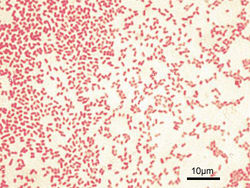Difference between revisions of "Pseudomonas aeruginosa"
Fiorecastro (talk | contribs) |
m (Text replace - "[[Otitis Externa - Small Animal" to "[[Otitis Externa - Cat and Dog") |
||
| (One intermediate revision by one other user not shown) | |||
| Line 1: | Line 1: | ||
| + | {{review}} | ||
{{Taxobox | {{Taxobox | ||
| Line 53: | Line 54: | ||
''P.aeruginosa'' bacteria have multiple antibiotic resistance, mediated by large plasmids carrying resistance genes and also chromosomal genes and mutations. Gentamicin or tobramycin with carbenicillin or ticarcillin, as well as polymyxin B are effective. | ''P.aeruginosa'' bacteria have multiple antibiotic resistance, mediated by large plasmids carrying resistance genes and also chromosomal genes and mutations. Gentamicin or tobramycin with carbenicillin or ticarcillin, as well as polymyxin B are effective. | ||
| − | + | ==Literature Search== | |
| − | | | + | [[File:CABI logo.jpg|left|90px]] |
| + | |||
| + | |||
| + | Use these links to find recent scientific publications via CAB Abstracts (log in required unless accessing from a subscribing organisation). | ||
| + | <br><br><br> | ||
| + | [http://www.cabdirect.org/search.html?q=title%3A%28%22Pseudomonas+aeruginosa%22%29+AND+od%3A%28Mink%29 ''Pseudomonas aeruginosa'' in mink publications] | ||
[http://www.cabdirect.org/search.html?q=title%3A%28%22Pseudomonas+aeruginosa%22%29+AND+od%3A%28cattle%29 ''Pseudomonas aeruginosa'' in cattle publications] | [http://www.cabdirect.org/search.html?q=title%3A%28%22Pseudomonas+aeruginosa%22%29+AND+od%3A%28cattle%29 ''Pseudomonas aeruginosa'' in cattle publications] | ||
| Line 69: | Line 75: | ||
[http://www.cabdirect.org/search.html?rowId=1&options1=AND&q1=%22Pseudomonas+aeruginosa%22&occuring1=title&rowId=2&options2=AND&q2=&occuring2=freetext&rowId=3&options3=AND&q3=&occuring3=freetext&publishedstart=2000&publishedend=yyyy&calendarInput=yyyy-mm-dd&la=any&it=any&show=all&x=31&y=4 ''Pseudomonas aeruginosa'' publications since 2000] | [http://www.cabdirect.org/search.html?rowId=1&options1=AND&q1=%22Pseudomonas+aeruginosa%22&occuring1=title&rowId=2&options2=AND&q2=&occuring2=freetext&rowId=3&options3=AND&q3=&occuring3=freetext&publishedstart=2000&publishedend=yyyy&calendarInput=yyyy-mm-dd&la=any&it=any&show=all&x=31&y=4 ''Pseudomonas aeruginosa'' publications since 2000] | ||
| − | |||
| − | |||
| − | |||
| − | |||
| − | |||
| − | |||
| − | |||
[[Category:Pseudomonas_and_Burkholderia_species]] | [[Category:Pseudomonas_and_Burkholderia_species]] | ||
Revision as of 16:30, 16 December 2010
| This article has been peer reviewed but is awaiting expert review. If you would like to help with this, please see more information about expert reviewing. |
| Pseudomonas aerginosa | |
|---|---|
| Phylum | Proteobacteria |
| Class | Gamma Proteobacteria |
| Order | Pseudomonadales |
| Family | Pseudomonadaceae |
| Genus | Pseudomonas |
| Species | P.aerginosa |
Overview
Pseudomonas aeruginosa is a species of the pseudomonas genus. It causes opportunistic infections requiring predisposing factors.
Pathogenesis
P.aeruginosa grows on few nutrients and can survive certain disinfectants. The bacteria has toxins and enzymes such as exotoxin A, phospholipase C and proteases that allow tissue invasion and damage. Elastase damages elastin in lung parenchyma and blood vessel walls. P.aeruginosa attaches to host cells via fimbrae and resists phagocytosis and complement via its LPS. It obtains iron from tissues.
Mink
P.aeruginosa causes haemorrhagic pneumonia and septicaemia in mink with 50% mortality via a secondary thrombocytopenic disease.
Cows
P.aeruginosa causes bovine mastitis associated with contaminated water used for washing udders; also metritis, pneumonia, dermatitis and enteritis in cattle.
Sheep
P.aeruginosa causes ovine fleece rot, also mastitis, pneumonia and otitis media.
Reptiles
P.aeruginosa causes necrotic stomatitis in captive reptiles.
Pigs
P.aeruginosa causes respiratory infections and otitis in pigs.
Horses
P.aeruginosa causes genital tract infections, pneumonia and ulcerative keratitis in horses.
Dogs and cats
P.aeruginosa causes otitis externa, cystitis, pneumonia and ulcerative keratitis in dogs and cats.
It can also cause deep pyoderma in all species.
Diagnosis
Specimens for diagnosis should include; pus, respiratory aspirates, mid-stream urine and ear swabs. Colonies can be identified on blood and MacConkey agar and are oxidative, not fermentative. The colonies only grow in aerobic conditions and produce diffusable pigments including pyocyanin, a green pigment, and fluorescine. On MacConkey agar, colonies have a fruity odour, are lactose negative and are pale in colour.
Treatment
P.aeruginosa bacteria have multiple antibiotic resistance, mediated by large plasmids carrying resistance genes and also chromosomal genes and mutations. Gentamicin or tobramycin with carbenicillin or ticarcillin, as well as polymyxin B are effective.
Literature Search
Use these links to find recent scientific publications via CAB Abstracts (log in required unless accessing from a subscribing organisation).
Pseudomonas aeruginosa in mink publications
Pseudomonas aeruginosa in cattle publications
Pseudomonas aeruginosa in sheep publications
Pseudomonas aeruginosa in reptiles publications
Pseudomonas aeruginosa in pigs publications
Pseudomonas aeruginosa in horses publications

